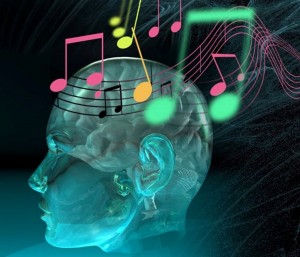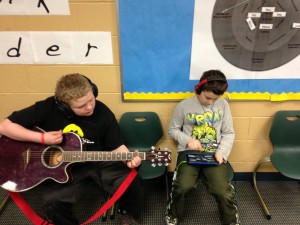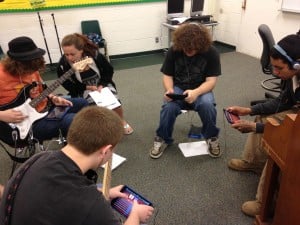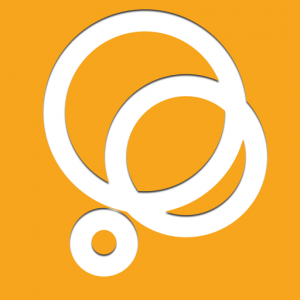
Making Thinking Audible
I have had the honor of hosting Harvard University’s Dr. Ron Ritchhart, principal investigator for the Cultures of Thinking Project and senior research associate for Project Zero in my classroom twice this year. I met Dr, Ritchhart in Clarkston, MI when I was attending the Cultures of Thinking teacher leadership cohort in 2012. Cultures of Thinking (CoT) are places where a group’s collective as well as individual thinking is valued, visible, and actively promoted as part of the regular, day-to-day experience of all group members. Learn more here.
CoT is supported by Making Thinking Visible (MTV), a book written by Dr, Ritchhart. Visible Thinking is a research based approach to teaching learners to become metacognitive. The book offers thinking routines which provide a framework for learners gathering thinking in different ways. These thinking routines are designed to bring the focus to the process of looking closely, thinking deeply, digging deeper, wondering about possibilities, and perspective taking. The thinking routines are not lesson plans, rather they focus on approaches to experiencing the world. I use thinking routines in the music room. It has changed our culture in the way musicians talk about their own thinking, other peoples’ thinking and the way musicians organize sound and silence. This year we are using the Headlines routine when sharing our thinking on our class Twitter account. I have witnessed the changes in learners’ thinking dispositions since supporting our thinking with thinking routines. I have written my own thinking routines that better meet the needs of the musicians who visit my classroom. “What’s Muddled” is a thinking routine I co-created with my previous principal and think partner Kristy Spann (@KristySpann). This routine was written with the revision process in mind. I used Nearpod to gather the musicians thinking. This routine helps focus the musicians’ reflection on their performance and musical decision making on what specifically didn’t come through as clearly as expected. These decisions inform their time revising process before their second iteration of the performance for the class.

Reflecting after performance
The more I continue to think about the authentic processes of being a musician and the shift in culture after beginning Making Thinking Visible, my thinking has changed. This looks (sounds) different in a music room. I consider the musical experience “Making Thinking Audible“. The way that musicians bring the focus to the process of looking closely, thinking deeply, digging deeper and wondering about possibilities is with sound, silence and the way we organize them. I teach Music Workshop. Musicians are listening, performing, creating and reflecting with sound. It gets loud and chaotic at points. That’s okay. There is a structure to the chaos. Learning is messy. In my classroom, learning is loud. There is no other way for musicians to experiment, think, compose, revise, collaborate, and perform without working with sound, loudly.. This can be done digitally with digital instruments, iDevices, JamHubs and headphones, which will quite the room down, but the audible thinking is still there in the headphones.

Create a digital/acoustic hybrid environment
When musicians are Making Thinking Audible, they are drawing from their prior experiences while constructing new understandings in-the-moment, reacting to the sounds and making decisions simultaneously. Similarly to CoT and MTV, the thinking needs to be collected, documented and reflected upon. It is generative. Our thinking cannot be written down on a sticky note and posted on an anchor chart. I am not referring to music notation, I am recommending capturing audio and/or video recordings of performances and compositions and reflections. This can be done transparently with an app called Three Ring.
Making Thinking Audible is a way to focus on the authentic processes of being a musician while supporting the way learners think in music. There is a difference thinking about music and thinking in music. When you think in music, you are iterating with sound. This requires marshaling the cultural forces in a way that supports this culture.
- Provide time for musicians to play (experiment with melody, timbre, orchestration, etc.) This is where I think about depth verse breadth. The more rich the musical experience, the deeper the their connections become.
- Design opportunities for musicians to listen, perform, and create music alone, in groups, on acoustic and digital instruments. Consider “Informances” where the musical experiences in the classroom can be transferred to the stage. The musicians explain their understanding to the audience and model the process of musicianship. This is an opportunity for parents and administrators to have a doorway into the process. Shifting the focus from product to process.
- Create routines and structures that are a part of the classroom culture. In my classroom, the musicians have shared understandings that we collaborate with other musicians to perform and create original music. The instruments are chosen by themselves and their ensembles and bands.
- Choose your language to foster a growth mindset and understanding that we are all on a continuum of understanding. Using language such as “I don’t know what chord to play…yet” or “my thinking has changed because…” or “what makes you say that?” Language can also be music and melody. There are many times where I may demonstrate and model something like improvisation without words. I answer learners verbal questions with melodic answers. Making my thinking audible.
- Creating a culture where the learners and teacher are co-creating their understandings is essential in a CoT. Interactions and relationships are the scaffolding of this culture. Without a supportive risk-taking environment, the other cultural forces suffer.
- Create a physical environment where musicians can collaborate and create within the same room comfortably.
- My expectations for learners is that we are supportive musicians that are furthering our understanding of the dimensions and metadimensions of music. Everyone learns differently and creates music in their own ways. We expect that our thinking is valid and multiple perspectives are honored. Our music has a purpose. We are all on a continuum.

Divergency in the ways musicians show understanding
Dr. Ritchhart traveled to London, England after he left my classroom. I am looking forward to debriefing with him about his observations. This is quite a reflective time for me as an educator. I would also like to share my thinking about Making Thinking Audible with him.
Does you classroom look/sound like mine? Is that supported by learners, colleagues and administrators? Please share your stories.


Love reading about your classroom and teaching. So inspiring. I’ve already shared this posting with others! I’m struck by so many things in your teaching and writing, but two to comment on here:
1) your reference to students as “musicians.” you use the language of identity to allow students to step into a new role and way of being in your classroom.
2) The opportunities you create for students to act authentically as musicians by creating and revising music, by working with sound. Looking forward to talking more with you about that.
Ron
Thank you for insightful reply. There is a strong sense of identity here. The label “musician” implies dispositions that are specific to the art form. We engage in processes and create problem solving experiences that are authentic to the art. I would appreciate us continuing this dialogue and hop to see you again soon.
Great post Michael! You use some different vocabulary/jargon, but I read in what you describe many of the things I and my students have found so effective and rewarding in my own classroom, and which I describe in my book: musical creativity, project-based learning, Constructivist approach to music learning, giving students time to experiment, reflect, refine, hands-on/applied learning, teacher-as-coach, risk-taking, using technology to give voice to authentic creativity, performing/documenting (exhibition), and meta-learning.
I hope you had a good time with the folks of PMEA 7 on Monday. I spoke their last year…it’s only about an hour from where I live/teach. Hopefully our paths will cross one of these days 🙂
Thank you Scott! I do frame the musician’s experience in a constructivist frame. Music is a collaborative art and understanding is socially constructed. The musicians have an environment where they are able to create, revise, and reflect in a supportive, risk-taking way. I enjoyed Using Technology To Unlock Musical Creativity and am excited to hear that you have a new book being published.
I had a great time PMEA 7! What a great group of passionate teachers. I look forward to presenting at their state conference! If I had a car of my own, I would have come to visit you. I’m sure our paths will cross soon.
This is a great post. From a pedagogical point of view, I am impressed with the clarity and logical flow of what you have written. Someone who is new to these ideas can see how they make sense because of the way you have structured your thoughts.
From a musical point of view, the idea that students are thinking in music resonates strongly with me. Although it was never really something I did well (hence my move to supporting regular classroom instruction) but I knew many fellow musicians who understood the world that way. Artists and literary folks speak of the mind’s eye. We used to speak of the mind’s ear. I think it impacts spatial understanding (which is what Fran Raucher’s work found) in that students know where the next sound is on their instruments in relation to other sounds they are hearing – either externally or internally. It relates to the ability to read music. The general notion is that if you can’t read it, you can’t play it and that may ultimately be the case. But, I always took the position that, in the beginning stages, if you can’t hear it, or in some cases, play it, you can’t read it. I used this construct as a basis for teaching my choral students to see on paper what they heard in their heads.
These ideas also allow students to come to recognize sophisticated compositional techniques. What has the composer done to arrive at what s/he wanted to say with music? Consequently, students develop a greater appreciation for more sophisticated works that require refined compositional techniques. And, of course, this crosses all styles and genres. (Remember my “you really turned me on to Pink Floyd” story?) As individuals mature in their ability to hear, they widen their opportunities for aesthetic experience.
Finally, as Jackie and I have discussed for years, it is interesting how closely this aligns with the way learners become intrigued by, knowledgeable in, and competent as readers and writers. I assume that is implied with your use of the term Music Workshop. What about calling it Musicin’s Workshop since, although the music is the center, the workshop is less about constructing a piece of music and more about developing learners as musicians.
Bob
Thank you for the thoughtful reply Bob. I love the idea that this is a Musician’s Workshop. Much like readers, writers, and math workshop, where the growth of the learner is at the center of the experience within different contexts, Musician’s Workshop develops the learner in the context of music. I have had many conversations with colleagues about reading standard notation in a primary music setting. I use a language learning analogy to help frame our dialogue. When we are learning a language, it’s messy. We experiment with sounds and learn how sounds blend ebb and flow together to express our emotions and thoughts. We would never ask a toddler who was learning how to communicate to read the words s/he wanted to say. Written words become hurdles for children if they don’t fully understand the sounds the letters make and how they blend together. Same with standard notation. Thank you for the insight. My thinking has changed and I will continue to call my classroom experience Musician’s Workshop.
Excellent post. The “learning is messy/learning is loud” quote really resonated with me. Actively doing musical things should be an integral part of every music classroom, and yes, that can look very chaotic to an outsider. By doing seemingly simple things like allowing students space to experiment, or encouraging them to collaborate, you’re creating a space that encourages passion and creativity. I’m going to take this post as a reminder to do more of this in my own classroom, and share it with my colleagues as well.
I deeply appreciate how what you’re doing centers your student thinking on goal making and growth. I think that we need to be doing things like this more often and more intentionally in schools. You are creating members of society who can think through a problem, make a plan, continuously assess themselves, and then reflect and learn from the process as a whole. If all schools did this more intentionally I think it would inspire a profound shift in our societal thinking over the next generation
Could you explain more in depth how you use Three Ring? We use Seesaw to capture learning, reflect, but I wish it was a bit easier to make it more collaborative.